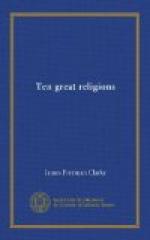Within a few years new materials for this study have been made accessible by the labors of Weil, Caussin de Perceval, Muir, Sprenger, Doellinger, and Arnold. Dr. Gustav Weil published his work[383] in 1843. It was drawn from Arabic manuscripts and the Koran. When Weil began his studies on Mohammed in 1837, he found no book except that of Gagnier, published in 1732, from which he could derive substantial aid. But Gagnier had only collected, without any attempt at criticism, the traditions and statements concerning Mohammed believed by orthodox Moslems. Satisfied that a literary want existed at this point, Dr. Weil devoted himself to such studies as should enable him to supply it; and the result was a work concerning which Milman says that “nothing has escaped” the diligence of its author. But four years after appeared the book of M. Caussin de Perceval,[384] a work of which M. Saint-Hilaire says that it marks a new era in these studies, on account of the abundance and novelty of its details, and the light thrown on the period which in Arabia preceded the coming of Mohammed. Dr. A. Sprenger, an eminent German scholar, early determined to devote himself to the study of Oriental literature in the East. He spent a long time in India, and was for twelve years principal of a Mohammedan school in Delhi, where he established, in 1845, an illustrated penny magazine in the Hindoo language. After returning to Europe with a vast number of Oriental manuscripts, he composed his Life of Mohammed,[385] the result of extensive studies. Among the preparations for this work we will cite only one. Dr. Sprenger edited in Calcutta the first volume of the Icaba, which contains the names and biographies of eight thousand persons who were personally acquainted with Mohammed.[386] But, as if to embarrass us with riches, comes also Mr. Muir[387] and presents us with another life of the prophet, likewise drawn from original sources, and written with learning and candor. This work, in four volumes, goes over the whole ground of the history of Arabia before the coming of the prophet, and then, from Arabic sources, narrates the life of Mohammed himself, up to the era of the Hegira. The result of these researches is that we know accurately what Mr. Hallam in his time despaired of knowing,—all the main points of the history of Mohammed. There is no legend, no myth, to trouble us. M. Saint-Hilaire says that the French are far less acquainted with Charlemagne than the Moslems are with their prophet, who came two centuries earlier.




